- This page was last modified on 17 October 2025, at 10:18. Suggest an edit.
National Museum of Nuclear Science & History facts for kids
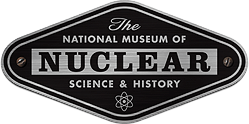 |
|
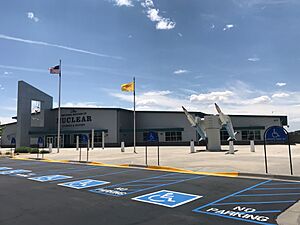 |
|
| Established | 1969 |
|---|---|
| Location | 601 Eubank Blvd SE, Albuquerque, NM 87123 |
| Type | Atomic History and Science museum |
| Accreditation | American Alliance of Museums |
| Visitors | 68,978 (2023) |
| Public transit access | Central @ Eubank (ART) |
| Nearest parking | On-site (no charge) |
The National Museum of Nuclear Science & History is a special place that teaches us about nuclear science and history. It used to be called the National Atomic Museum. This museum is the official place in America for information about nuclear science. It is located near Albuquerque, New Mexico, next to Kirtland Air Force Base.
The museum's main goal is to be America's go-to place for nuclear history and science. It shows exhibits and offers fun learning programs. These programs help everyone understand the people and events that shaped the "nuclear age."
Contents
How the Museum Started
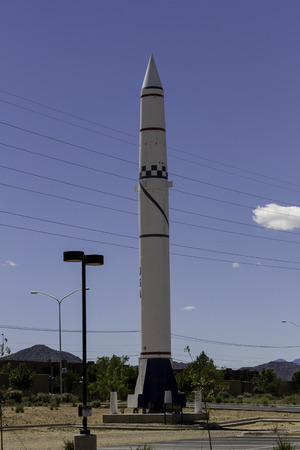
A Redstone rocket on display at the museum.
The museum first opened in 1969. It was on the grounds of Sandia Base, which is now part of Kirtland Air Force Base. Back then, it was called the "Sandia Atomic Museum." It took six years to create this museum. Its purpose was to share the story of the base and how nuclear weapons were developed. Air Force staff and people from Sandia National Laboratories helped run it.
In 1973, the museum's name changed to "National Atomic Museum." However, it wasn't officially a national museum yet. The United States Department of Energy (DOE) took over in 1985. This meant the staff became DOE employees.
Becoming a National Museum
In 1991, the museum officially became a national museum. Its mission grew to include more than just nuclear weapons. It started covering all parts of nuclear science and history. The museum also joined forces with the Smithsonian Institution. A non-profit group, the National Atomic Museum Foundation (NAMF), was created in 1992. This group helps run and fund the museum, reducing costs for taxpayers.
In 1995, the DOE handed the museum's operations to Sandia National Laboratories. Then, after the terror attacks in September 2001, security became very strict. It was hard for the public to visit the museum on the base. So, the museum had to move to a new spot in Old Town Albuquerque.
Moving to a New Home
In 2005, the NAMF took over running the museum. The museum needed more space for its outdoor exhibits. So, in January 2005, NAMF asked for land to build a new, bigger museum. They found a great spot at Eubank and Southern Boulevards in southeast Albuquerque.
Construction began, and the museum staff even shared photos of the building's progress online. The new museum officially opened on April 4, 2009. It also got its current name: the National Museum of Nuclear Science & History.
Many groups helped pay for the new building. The US government gave $5 million. The State of New Mexico and the City of Albuquerque provided $1 million for things like roads. Companies, foundations, and individuals also donated money.
The new museum has 16 indoor exhibit areas, two classrooms, a theater, and a library. It also has a gift shop. All this covers about 30,000 square feet. Outside, there are 9 acres for large exhibits. These include military aircraft, rockets, missiles, and even part of a nuclear submarine!
The museum costs about $2.5 million each year to run. This money comes from ticket sales, memberships, grants, summer camps, and events.
What You Can See and Do
The museum works to save and share information about the Atomic Age. This includes science, history, and culture. Here are some of the permanent exhibits:
- Pioneers of the Atom – This interactive display introduces you to the scientists who studied and defined what atoms are. You can use a special screen to learn about the history of atomic study.
- World War II – This exhibit explains the history that led to the creation and use of the atomic bomb. It also shows which countries were involved in the war.
- Critical Assembly, the Secrets of Los Alamos 1944 – This special exhibit looks like a real laboratory. It shows how the first atomic bomb was put together. It uses real items from the 1940s to make it feel like you are there.
- The Decision to Drop – This part of the museum tells the story of the Manhattan Project. This project created and tested the world's first atomic bomb. You can learn about the scientists who lived at Los Alamos National Laboratory. You can also see how the first explosion happened in 1945 at the Trinity site. The exhibits try to show all sides of the story. They explain the choices made about using the first nuclear weapons, called Little Boy and Fat Man. You can read comments from scientists and leaders. You can also see photos from the Hiroshima Peace Memorial Museum. There are videos of Col. Paul Tibbets, who piloted the plane that dropped the bomb on Hiroshima, Japan.
- Hiroshima and Nagasaki – This exhibit honors the people affected by the atomic bombs. It shows pictures of these cities before, during, and after the bombings. It also highlights how these communities work for peace today.
- Cold War – This exhibit explores the long conflict between the United States and the Soviet Union. It covers US nuclear tests, Soviet nuclear development, and the Cuban Missile Crisis in 1962. It also talks about the end of the Soviet Union. You can learn about the 1966 Palomares B-52 crash. This was an accident where two US Air Force planes crashed, and four hydrogen bombs were accidentally dropped.
- Heritage Park – This is a huge 9-acre outdoor area. It has real planes, rockets, missiles, cannons, and even the sail (top part) of a nuclear submarine!
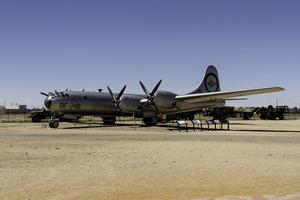
A B-29 Superfortress on display.
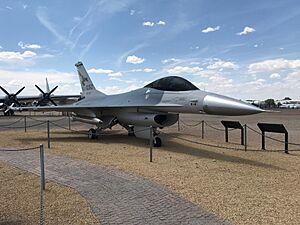
An F-16A on display with a pretend B61 bomb.
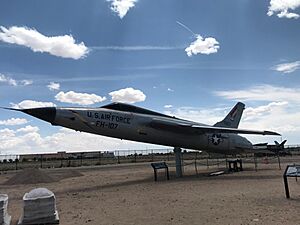
An F-105D Thunderchief on display.

A Boeing B-52B on display with an AGM-28 Hound Dog missile.

A Mig-21 on display.
- Nuclear Medicine – This display shows old and new medical tools that use nuclear physics.
- Little Albert's Lab – This is a fun, hands-on area for kids. An animatronic (robot) version of Albert Einstein guides you through science activities.
- Nano – This interactive exhibit helps you discover a world you can't see. You learn about tiny things in nanoscience. This display is now part of Little Albert's Lab.
- Energy Encounter – This section focuses on how nuclear power is used for peaceful purposes. It covers:
- The history of nuclear reactors and how they work.
- Information about nuclear power plant safety and how waste is handled.
- Models of nuclear power stations.
- A model of the NS Savannah, the first nuclear-powered merchant ship.
- How nuclear energy fits with other ways to make power.
- Radiation 101 – This display shows everyday items and activities that expose people to radiation.
- Atomic Pop Culture – See how American movies, comic books, and fashion showed the start of the Atomic Age.
- Nuclear Waste Transportation – You can see a TruPact II container here. This is a special container used to safely move nuclear waste.
- What's Up With U(ranium) – This exhibit helps answer questions like "where does uranium come from?" and "how does it affect us?"
- Uranium; Enriching Your Future – This exhibit explains how nuclear power helps create energy.
- Dark Cube: Heisenberg's Race for the Bomb – This special exhibit tells the story of Nazi Germany's attempt to build an atomic weapon. It features a real "dense, two-inch charcoal-black cube made of pure uranium metal."
- Nuclear by Mail – This exhibit shows how nuclear science and technology appeared on stamps and stationery throughout the 20th century.
- Temporary Exhibit Hall – This area always has new and changing exhibits.
You can explore the museum on your own or take a tour with a guide.
Special Items to See
The museum has many unique items, including:
- Casings (outer shells) of the Little Boy and Fat Man bombs.
- The only full-size copy of "Gadget" and the Trinity Test Tower.
- Different types of modern nuclear bombs and warheads.
- A WE.177 bomb, which was a British nuclear weapon.
- Two actual B28 bomb casings from the Palomares accident.
- Items showing daily life at Los Alamos National Laboratory during the Manhattan Project.
- A collection of fun items that show how the Atomic Age influenced American culture.
- An early X-ray device called a fluoroscope.
- A special camera (PRISM 2000 XP Gamma Camera) used in modern nuclear imaging.
- A display of old, sometimes strange, medical devices related to nuclear ideas.
- Many models of military aircraft and vehicles.
- A Lego model of Chicago Pile-1, the world's first artificial nuclear reactor.
- A cube of uranium that the Nazis used in their attempt to build an atomic weapon.
- A huge 260 mm M65 atomic cannon, often called "Atomic Annie."
When the museum first moved to Old Town, placing a Redstone rocket outside caused some discussion. Some people felt it showed too much military influence in the city. Others thought it was important to show New Mexico's role in the nuclear age. When the new museum opened, the Redstone rocket moved to its current location at the Eubank site.
Aircraft on Display
Because the museum is near Kirtland Air Force Base, it has several important aircraft.
| Type | Service Years | Interesting Fact |
|---|---|---|
| Boeing B-29 Superfortress | 1945–19?? | This plane was part of the group that carried nuclear weapons. |
| Boeing B-47E-111-BW | 1953–1970 | This plane was used to test new flight technology. |
| Boeing RB-52B-10-BO | 1953–1963 | This specific plane dropped many live nuclear bombs during tests. It's one of only seven ever built. |
| F-105D-20-RE | 1962–1981 | This plane was used for training and later for battle damage practice. |
| F-16A Block 5 | 1979–1997 | This plane is painted in the colors of the New Mexico Air National Guard. |
| TA-7C Corsair II | 1968–1991 | This plane was used during the Vietnam War. |
| Mig-21F Fishbed | 1975–19?? | This was a Hungarian Air Force plane, now displayed in Soviet Air Force colors. |
Learning and Community Fun
The museum offers many learning programs for kids, teens, and adults all year long. They even have a special "Up'n'Atom Mobile" that brings science to schools! These programs help New Mexico students meet their school curriculum standards.
The museum also hosts guest speakers, special events, and week-long science camps in the summer. You can even rent spaces at the museum for birthday parties, weddings, or other gatherings.
Other Museums to Explore
- American Museum of Science and Energy
- Bradbury Science Museum
- National Atomic Testing Museum
See also
 In Spanish: Museo Nacional de Ciencia e Historia Nuclear para niños
In Spanish: Museo Nacional de Ciencia e Historia Nuclear para niños



